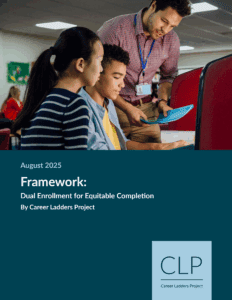 Dual enrollment allows a student to enroll in both high school and college at the same time, serving as an acceleration strategy for college completion. When implemented with the intention to serve as an equity lever, dual enrollment has been shown to be particularly effective for students from historically underserved groups including first-generation students, male students of color, and low income students. Equity-focused dual enrollment recognizes the capacity and builds upon the assets of students and their families to share the responsibility for student success between educational institutions, families, and community partners. When high-quality dual enrollment is integrated with other college success and completion efforts such as guided pathways, it can further accelerate students in reaching their goals.
Dual enrollment allows a student to enroll in both high school and college at the same time, serving as an acceleration strategy for college completion. When implemented with the intention to serve as an equity lever, dual enrollment has been shown to be particularly effective for students from historically underserved groups including first-generation students, male students of color, and low income students. Equity-focused dual enrollment recognizes the capacity and builds upon the assets of students and their families to share the responsibility for student success between educational institutions, families, and community partners. When high-quality dual enrollment is integrated with other college success and completion efforts such as guided pathways, it can further accelerate students in reaching their goals.
The guided pathways approach to community college redesign aims to center the students and clarify college and support pathways to and through college. Guided pathways includes a set of evidence-based community college reforms such as shortening or removing developmental English and math, requiring students to complete an educational plan with a counselor or advisor, and others. In many colleges, guided pathways includes a focus on how students first engage with the college—how they encounter the “front door.” For an increasing number of students, that front door is dual enrollment.
This publication was produced by Career Ladders Project with funding from the Gates Foundation and College Futures Foundation. The opinions expressed are those of the authors and do not represent views of the Gates Foundation or College Futures Foundation.